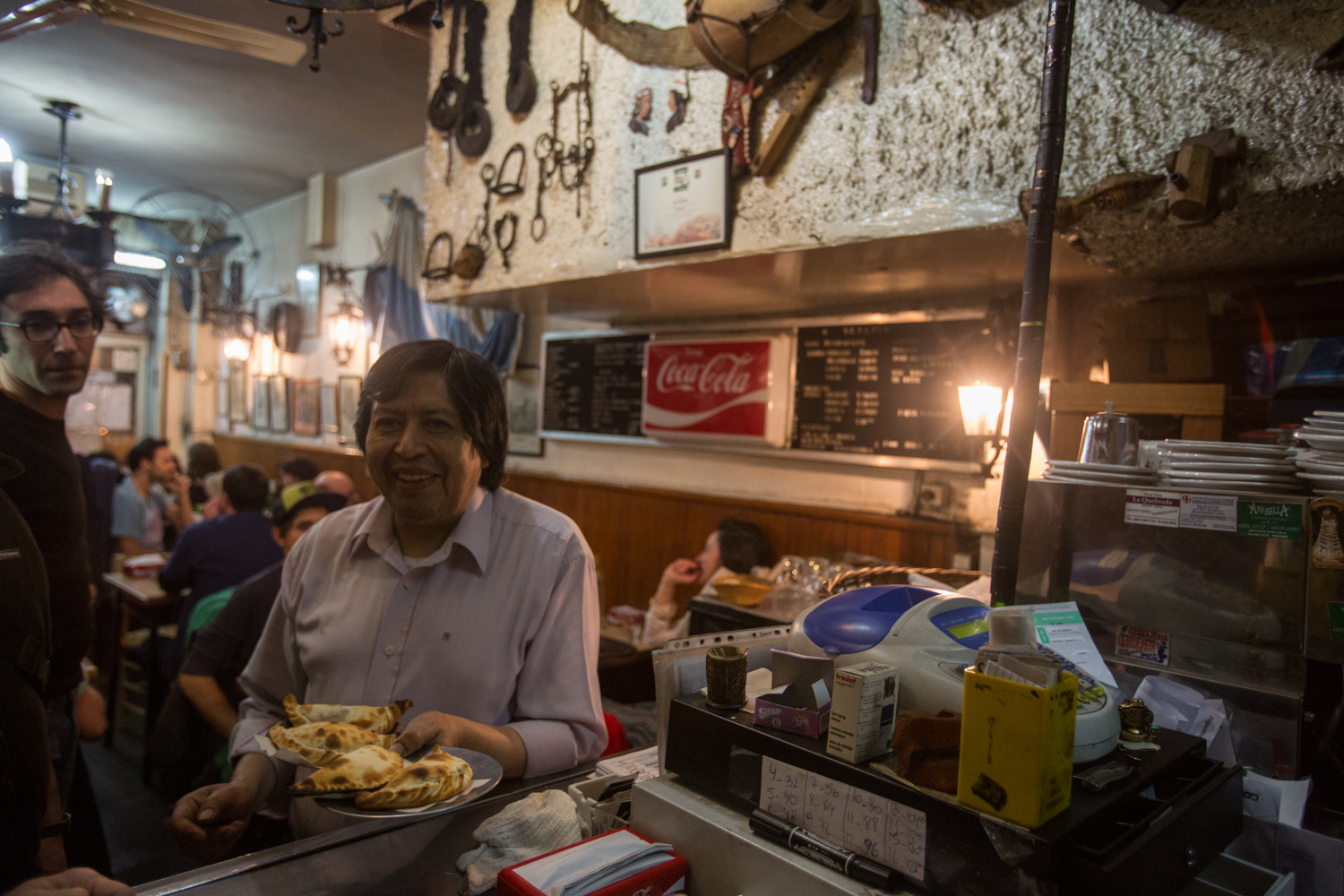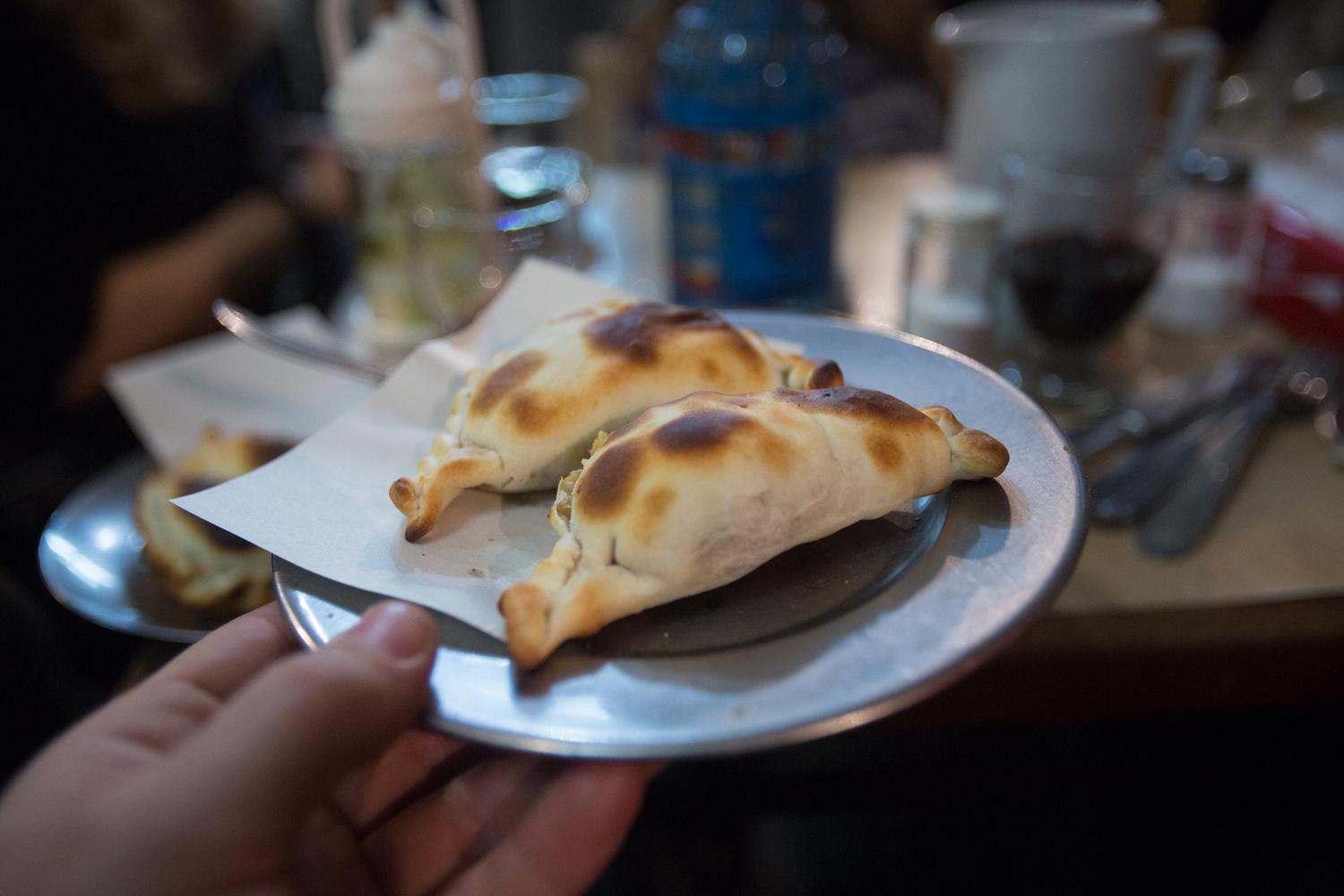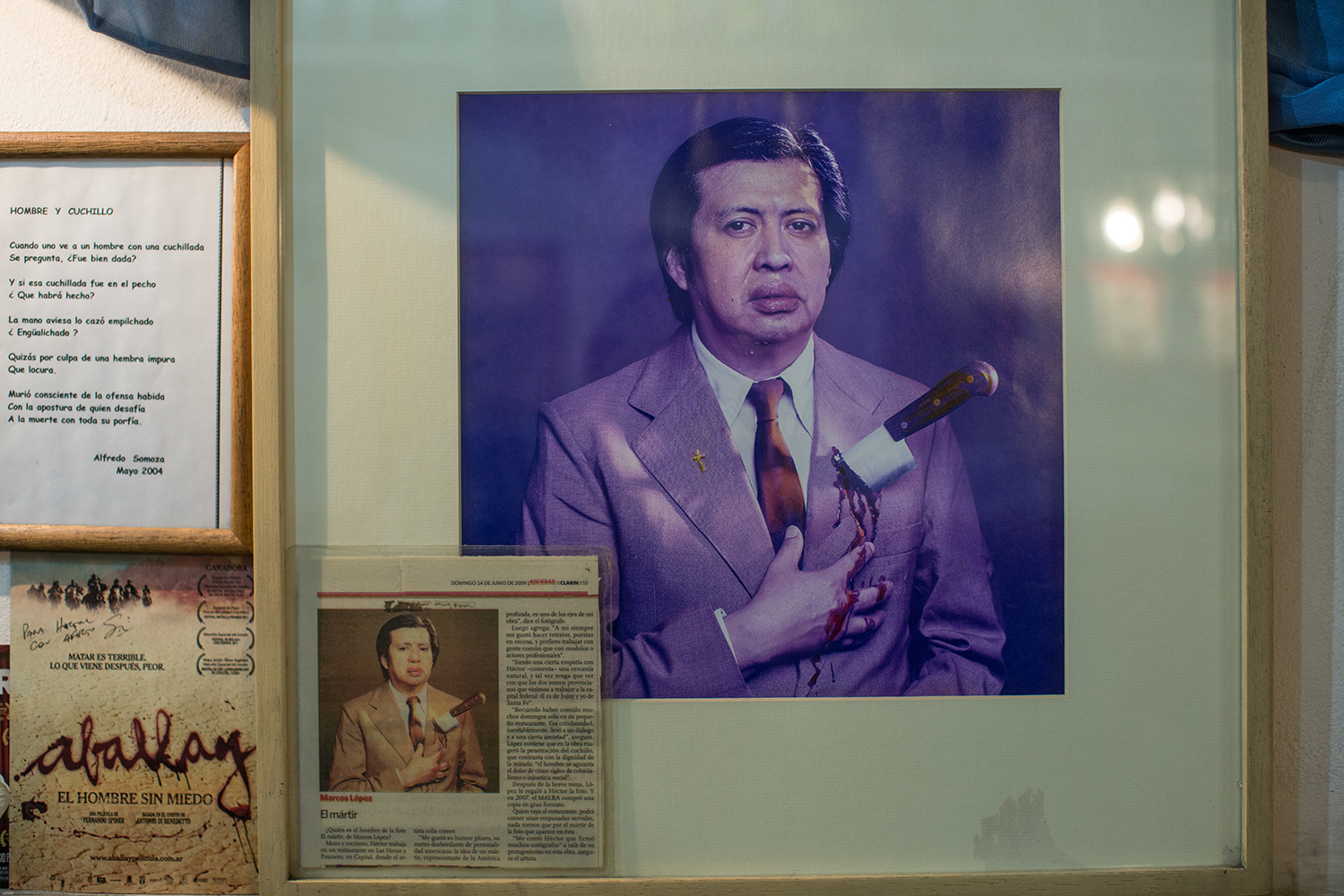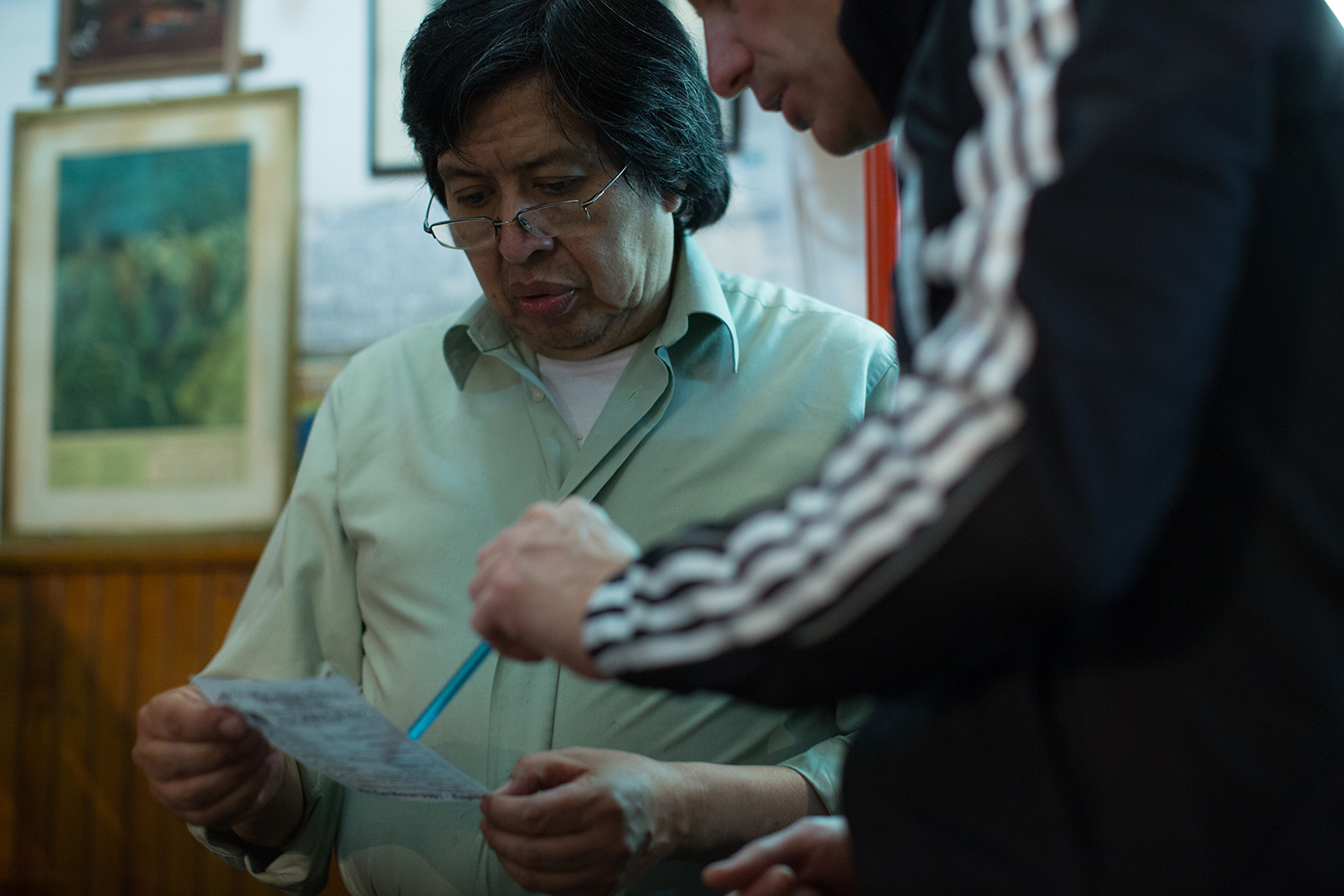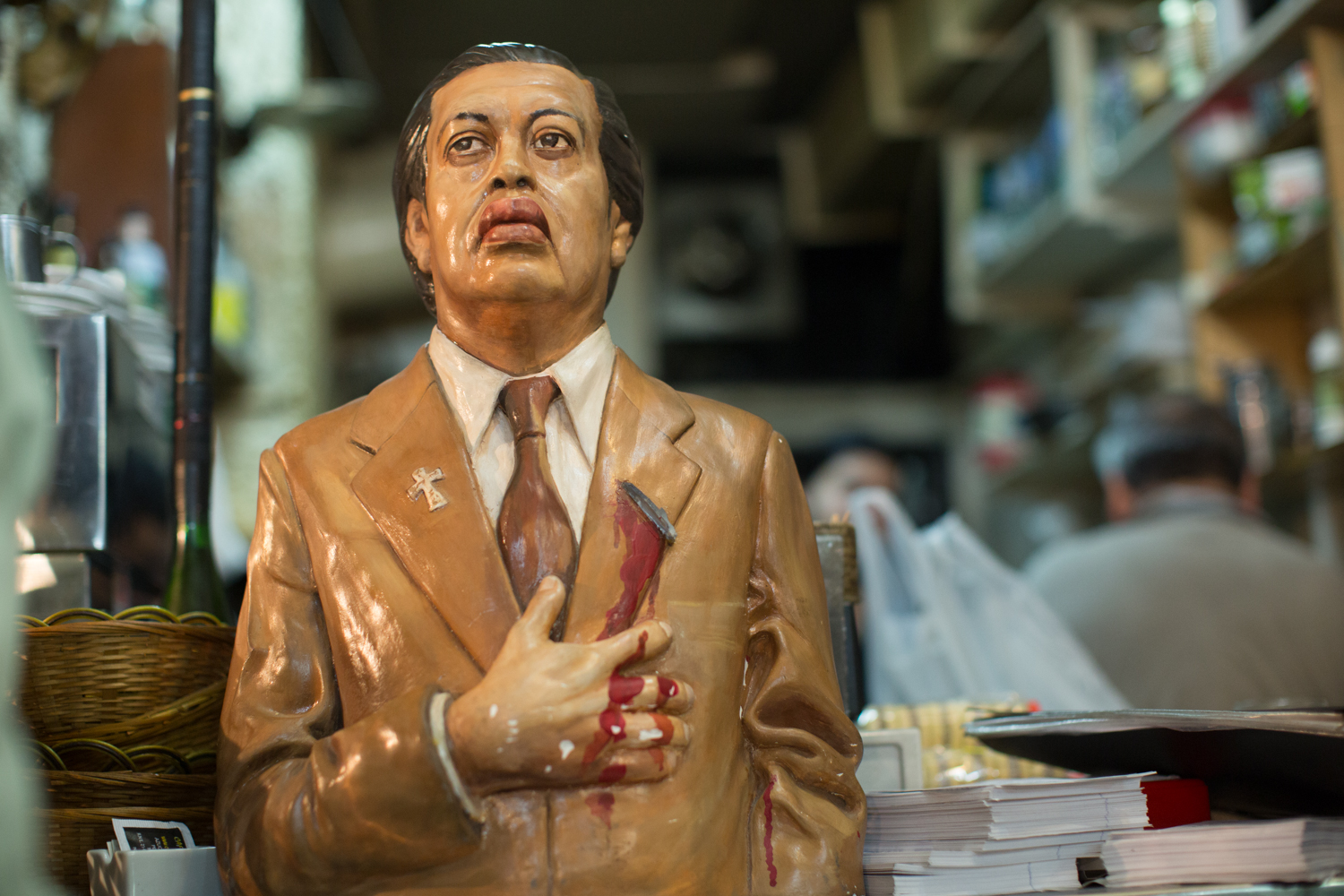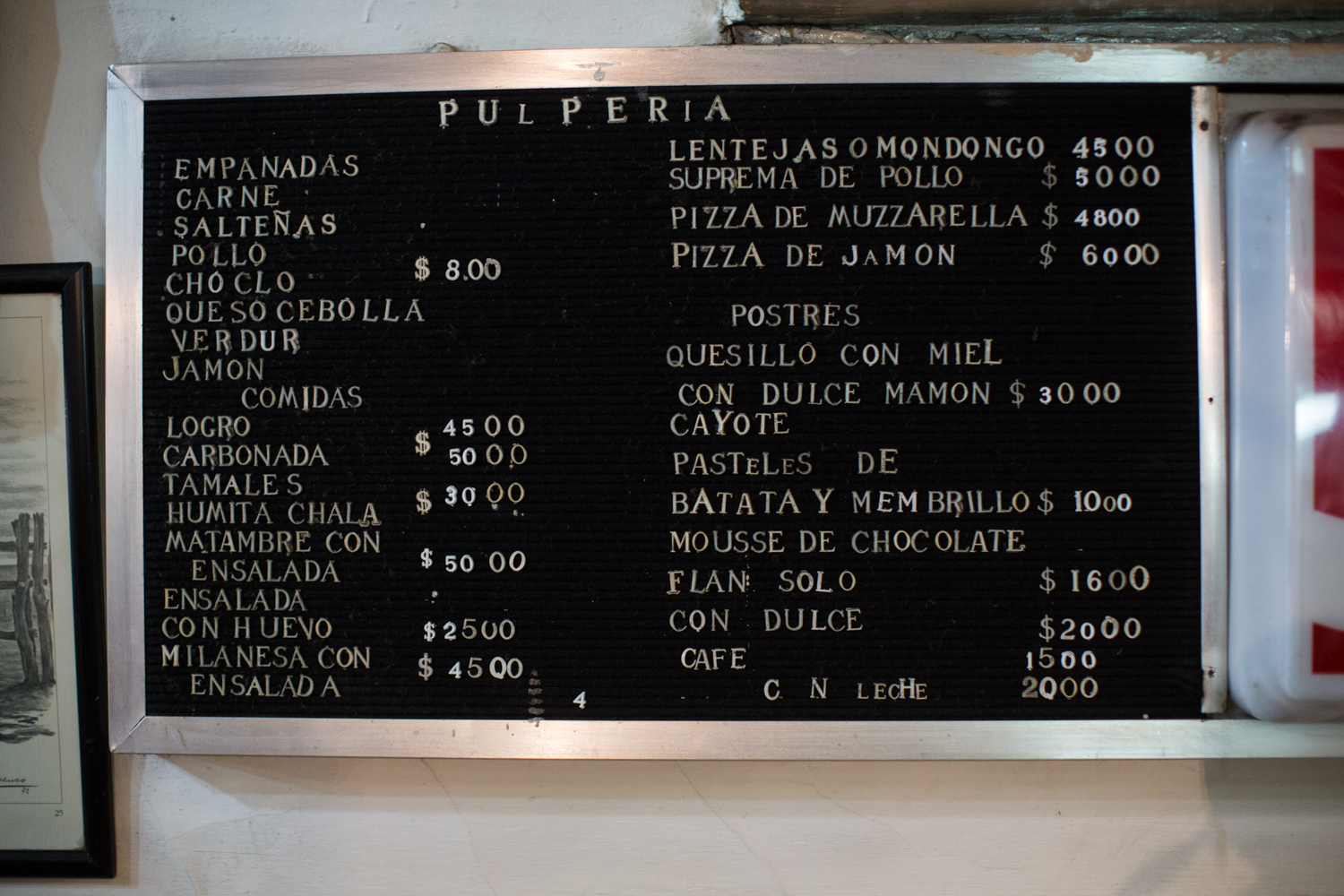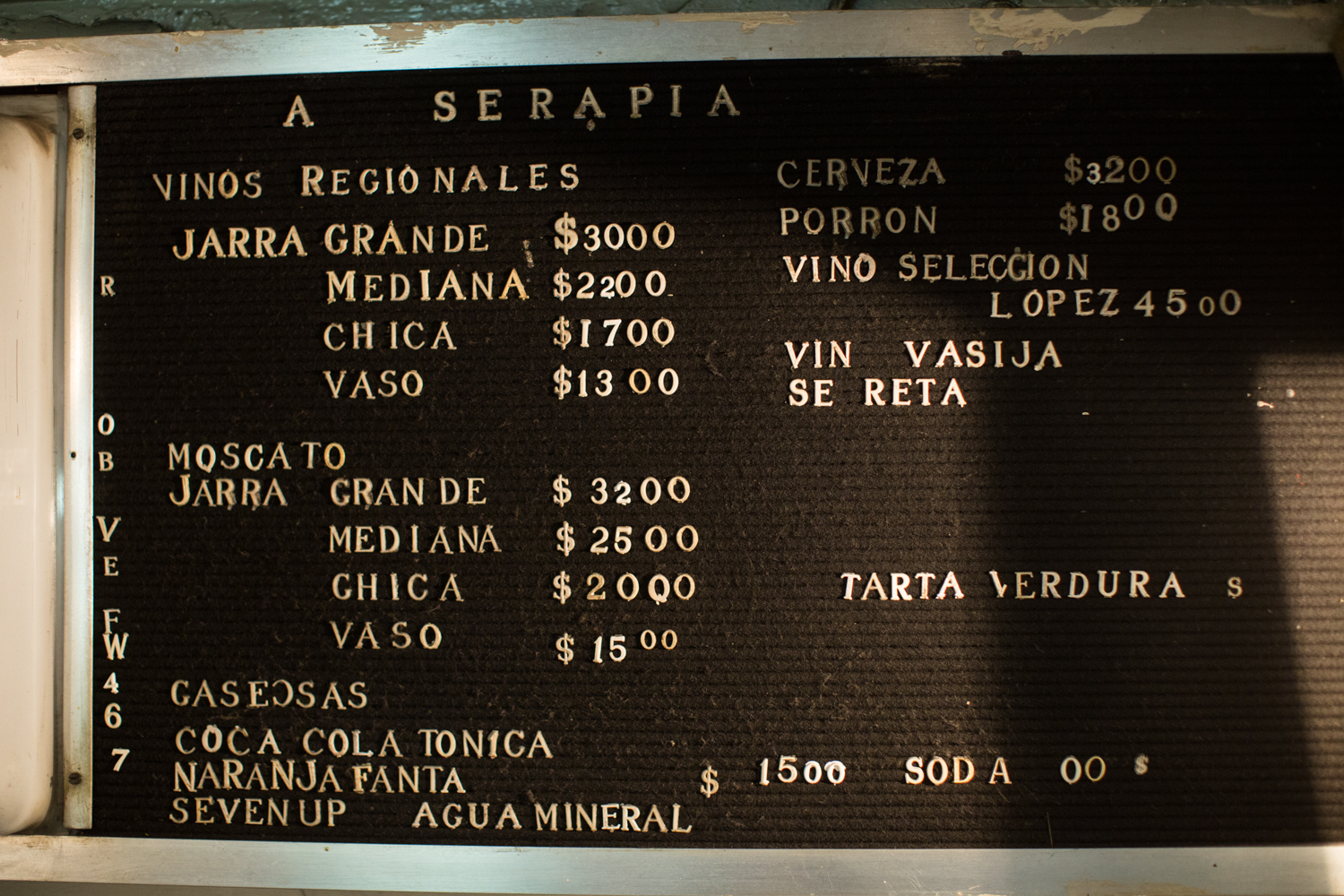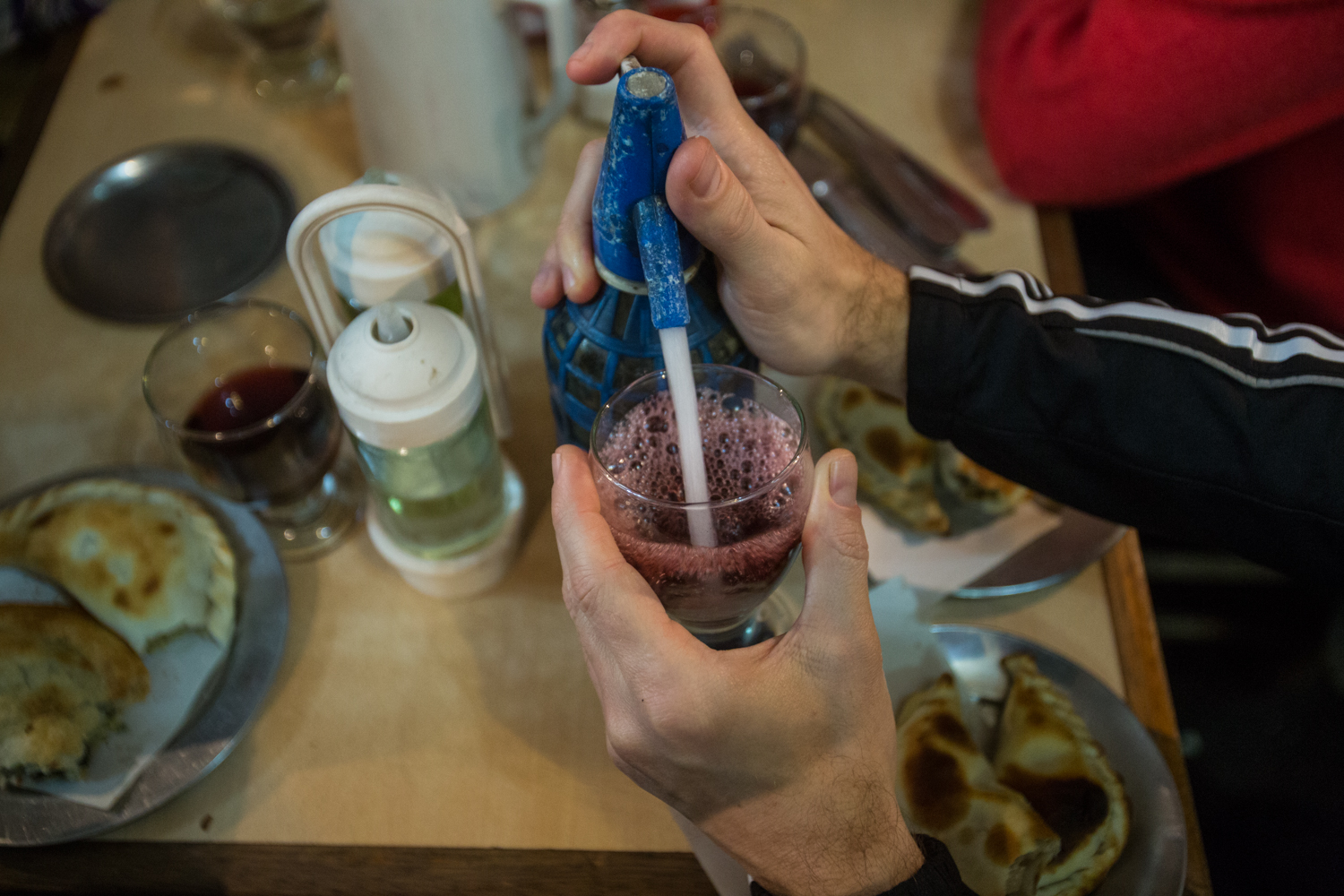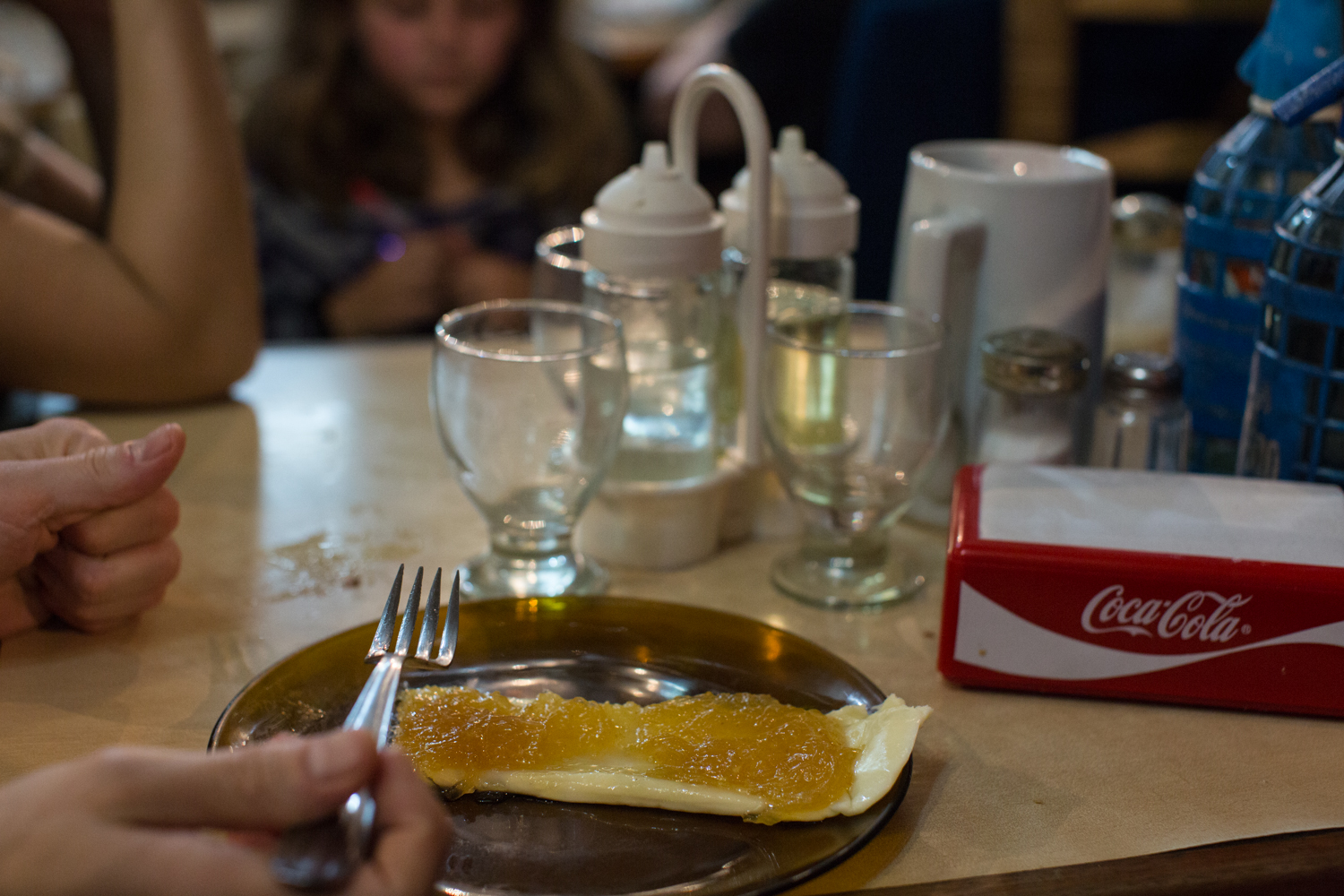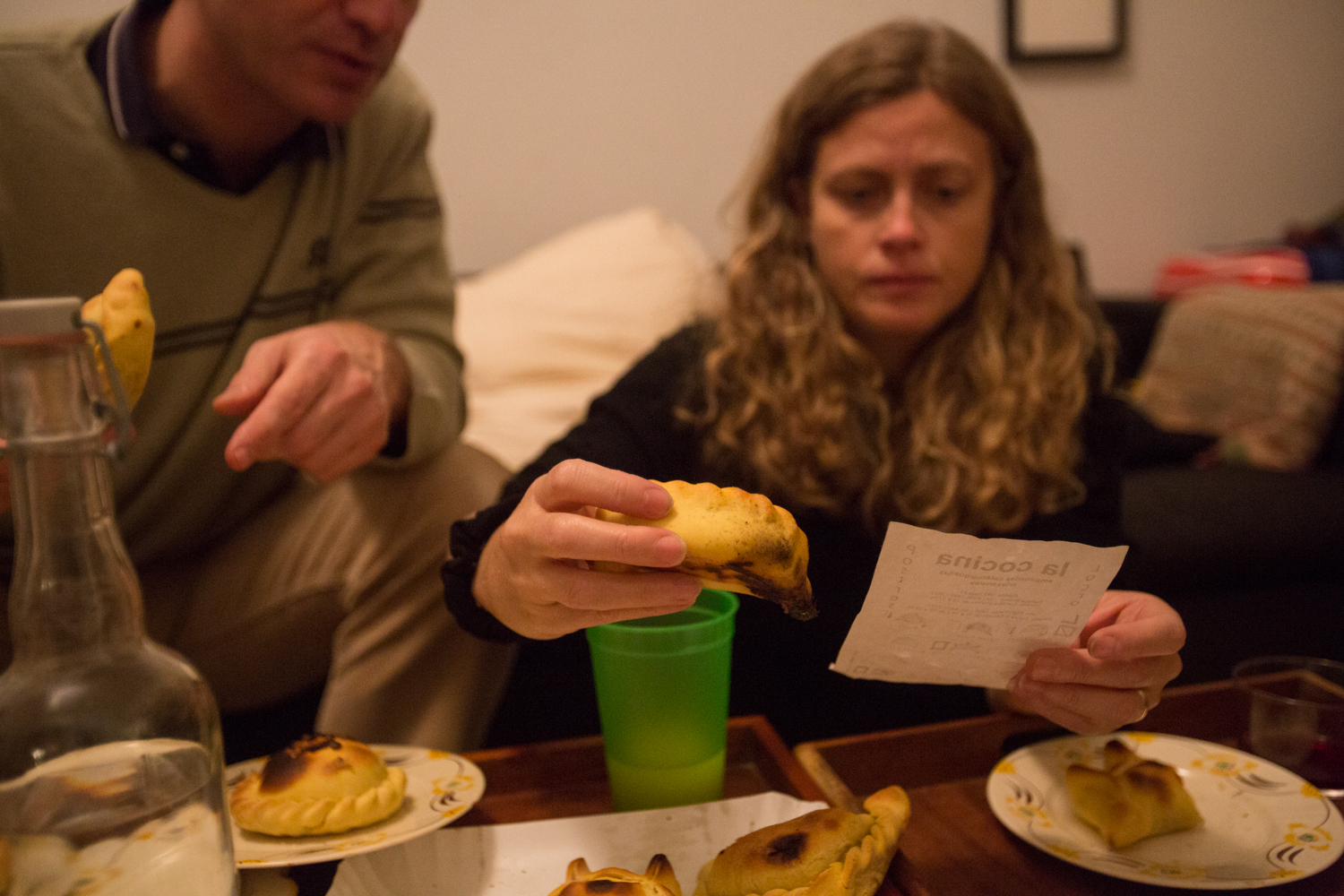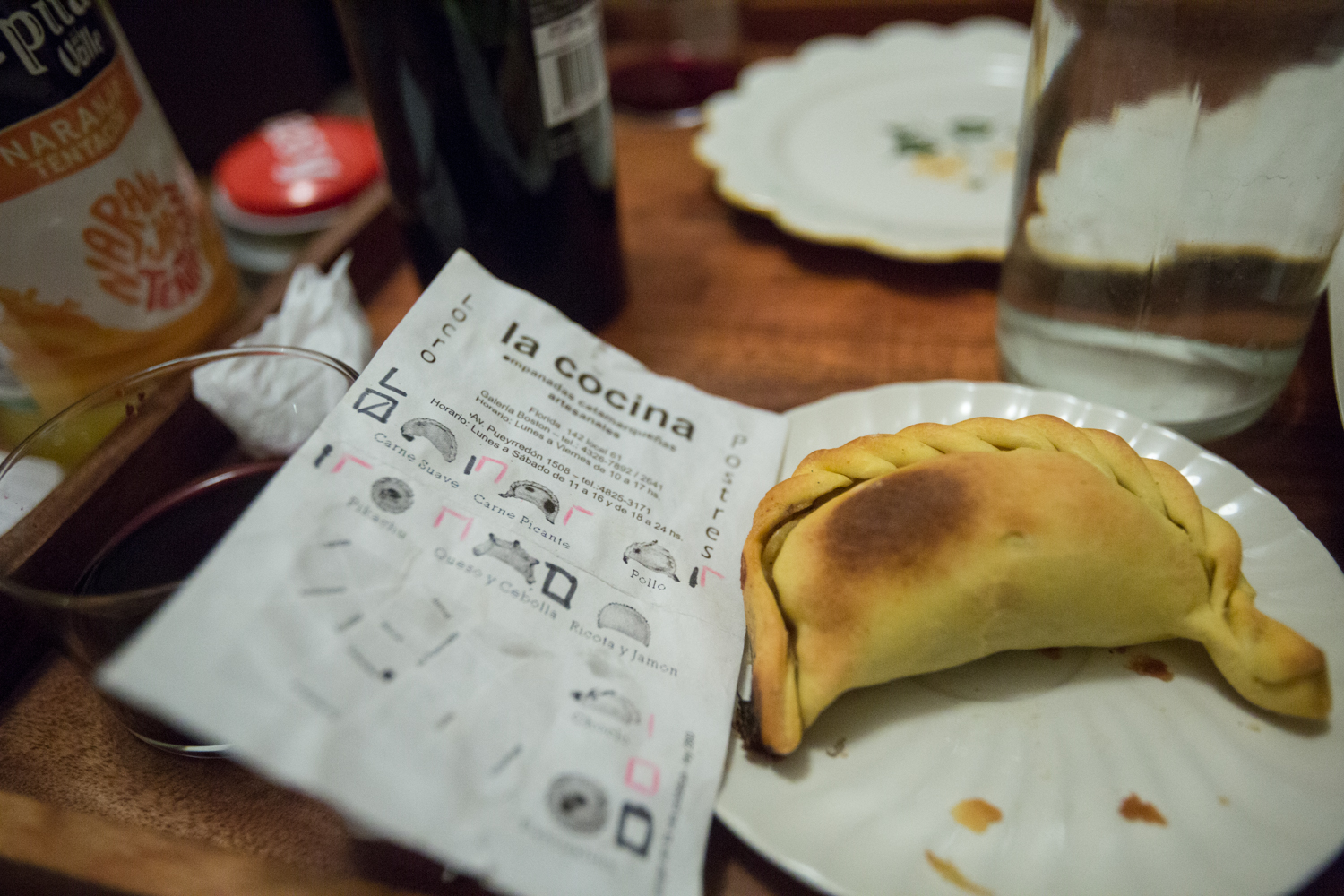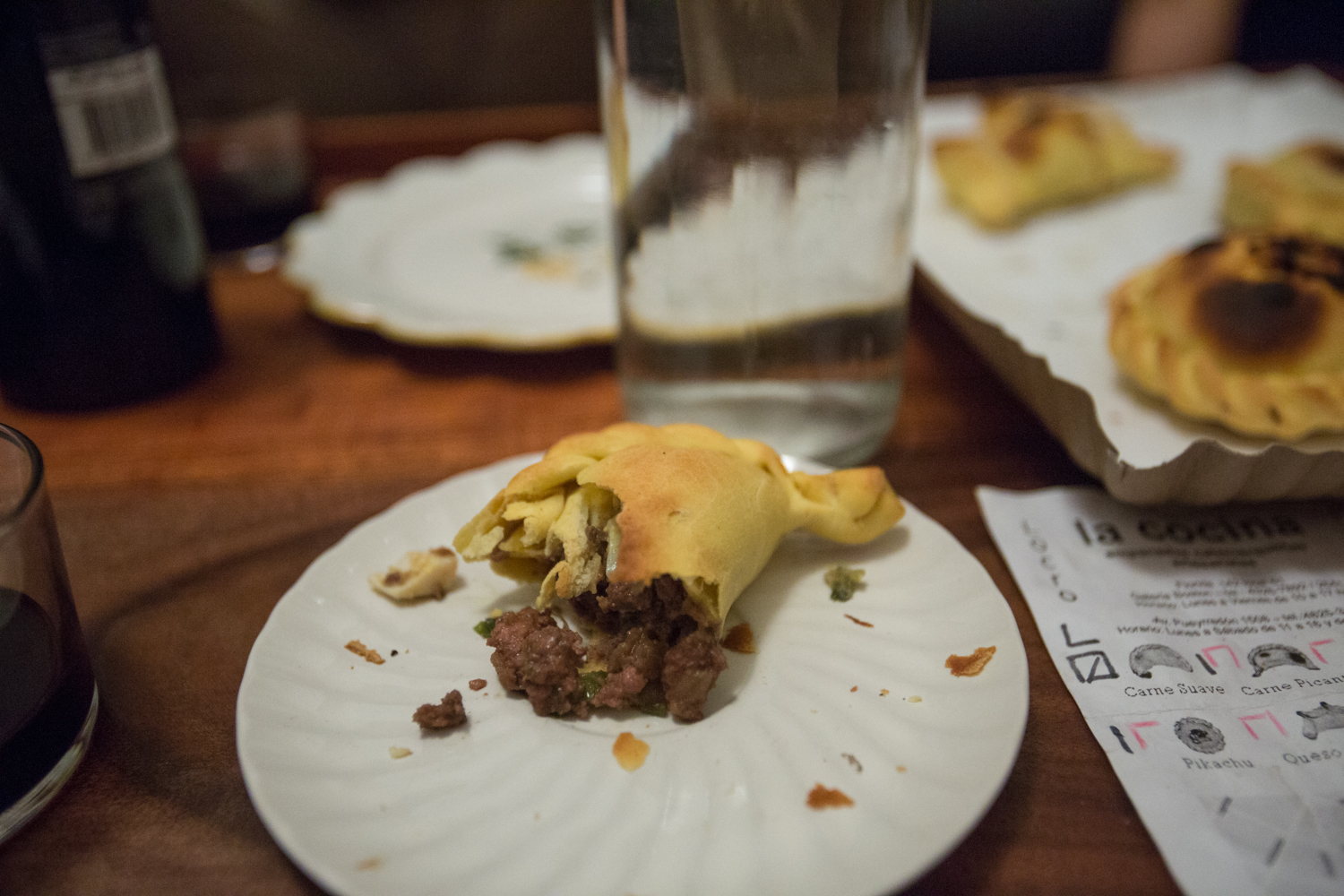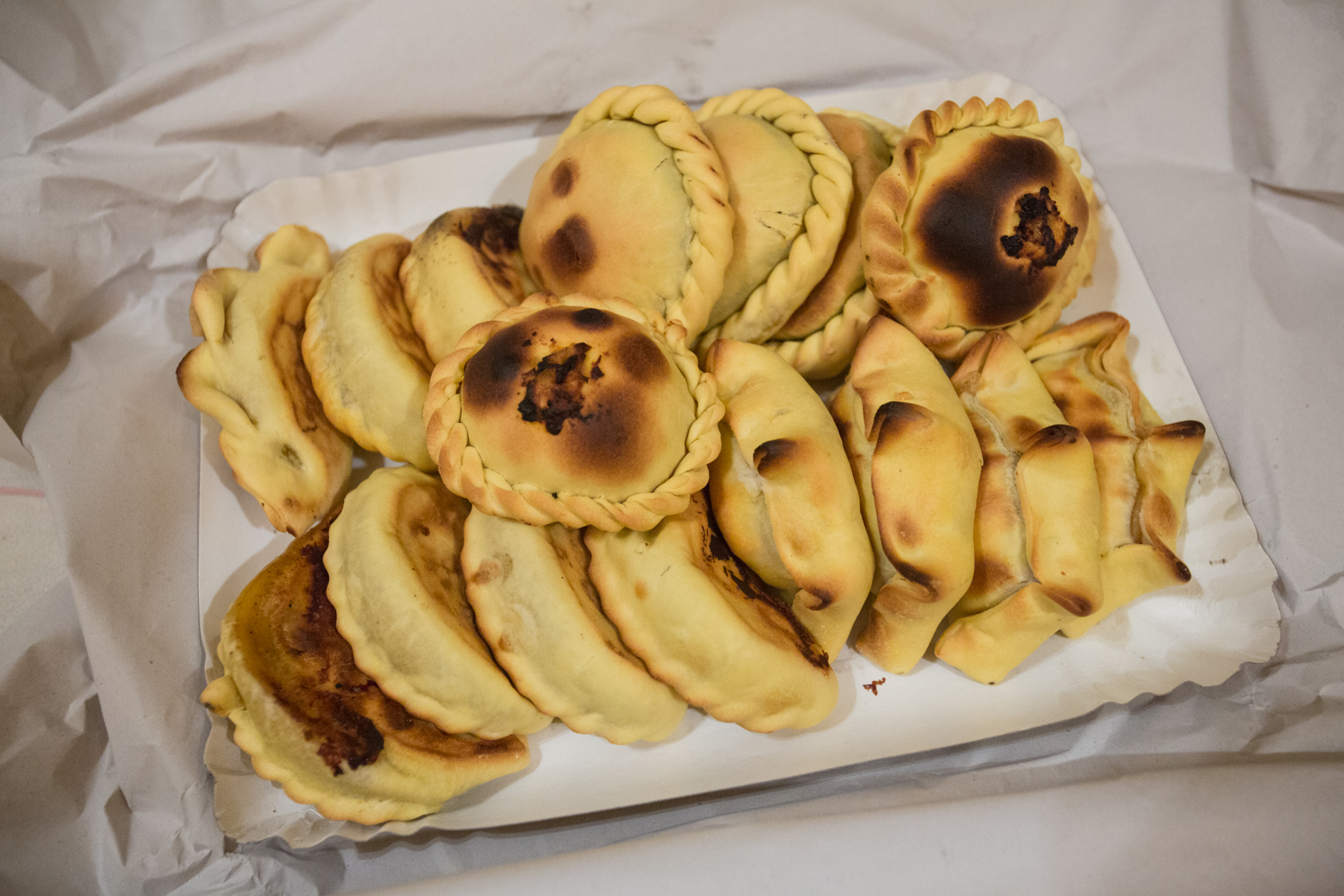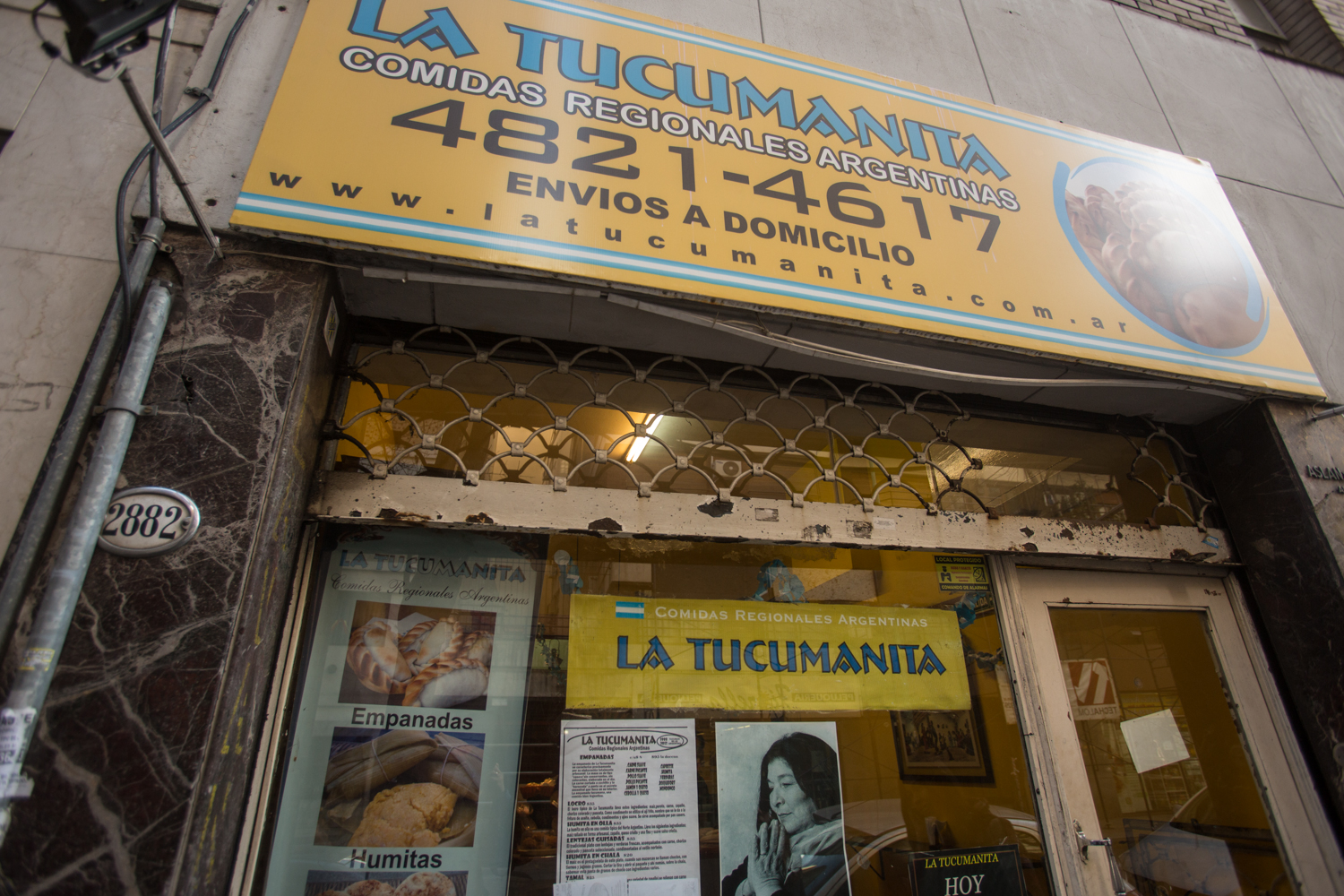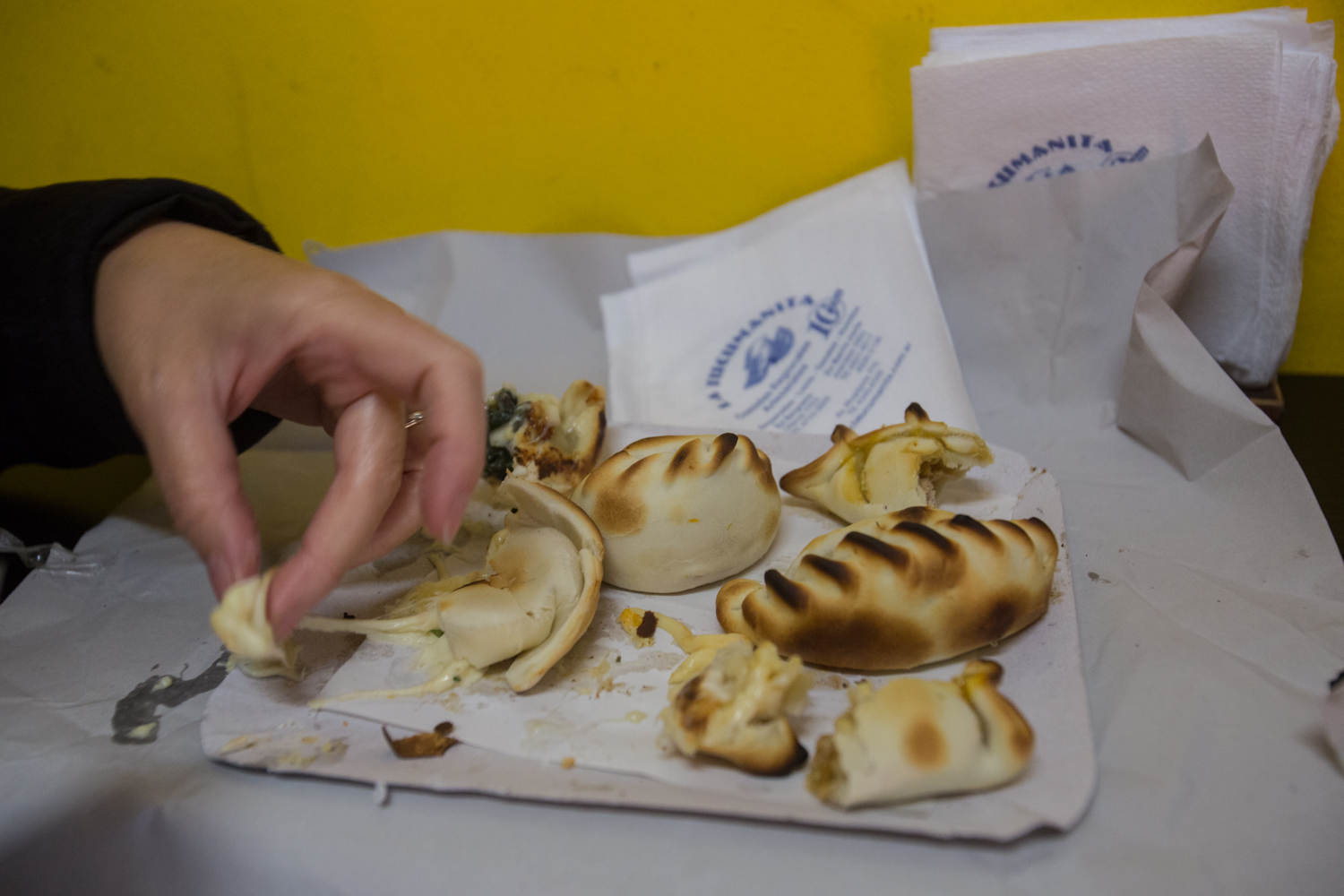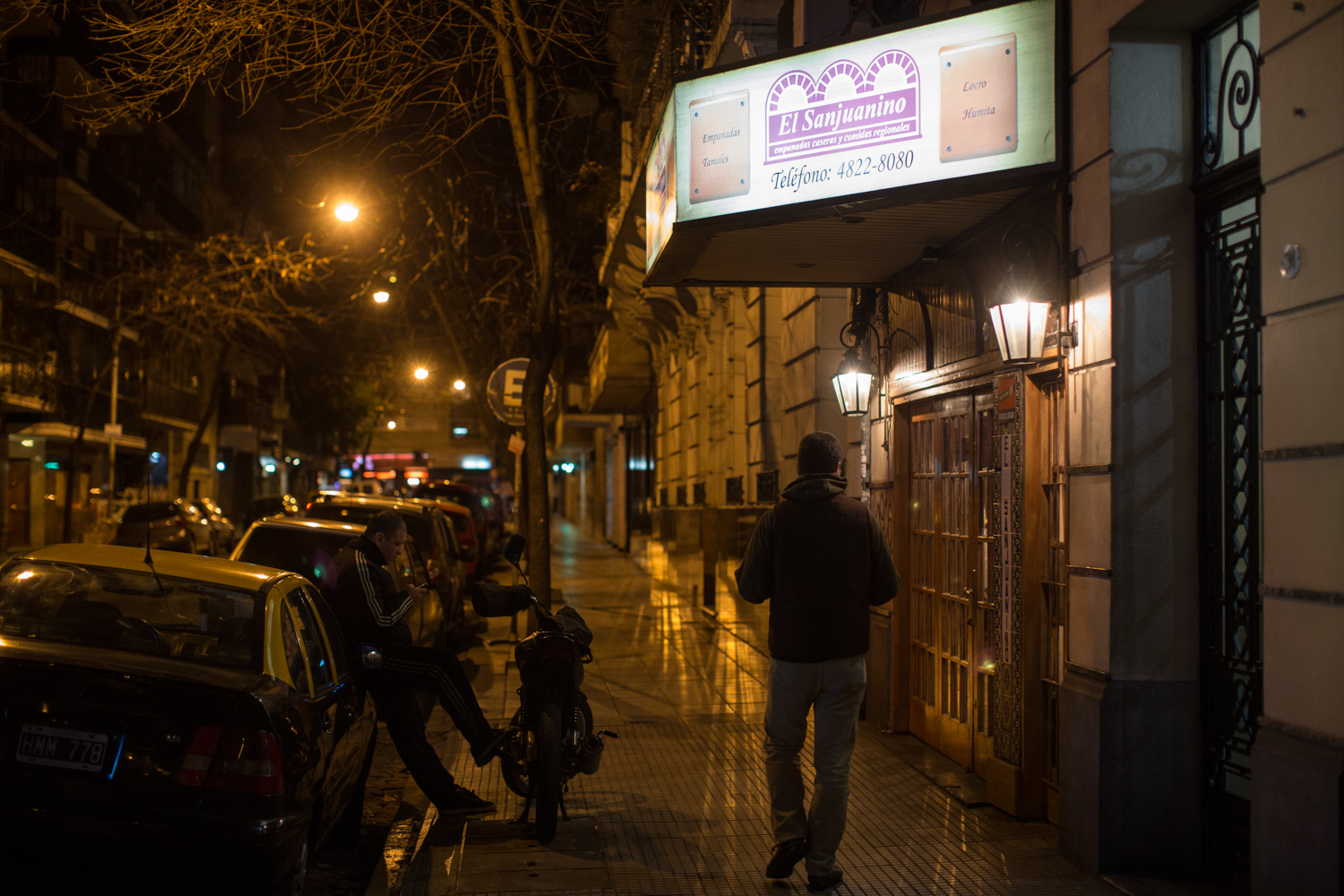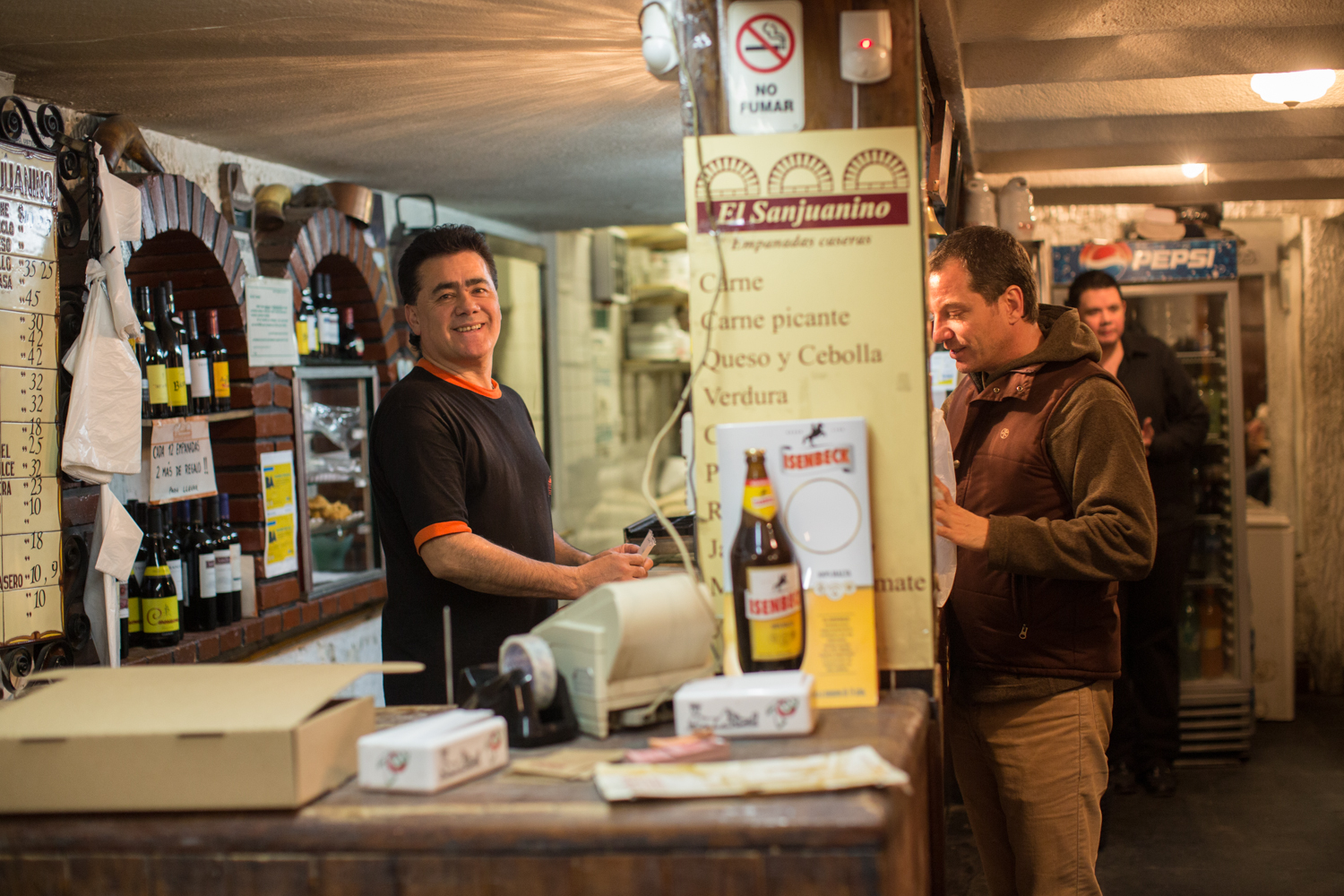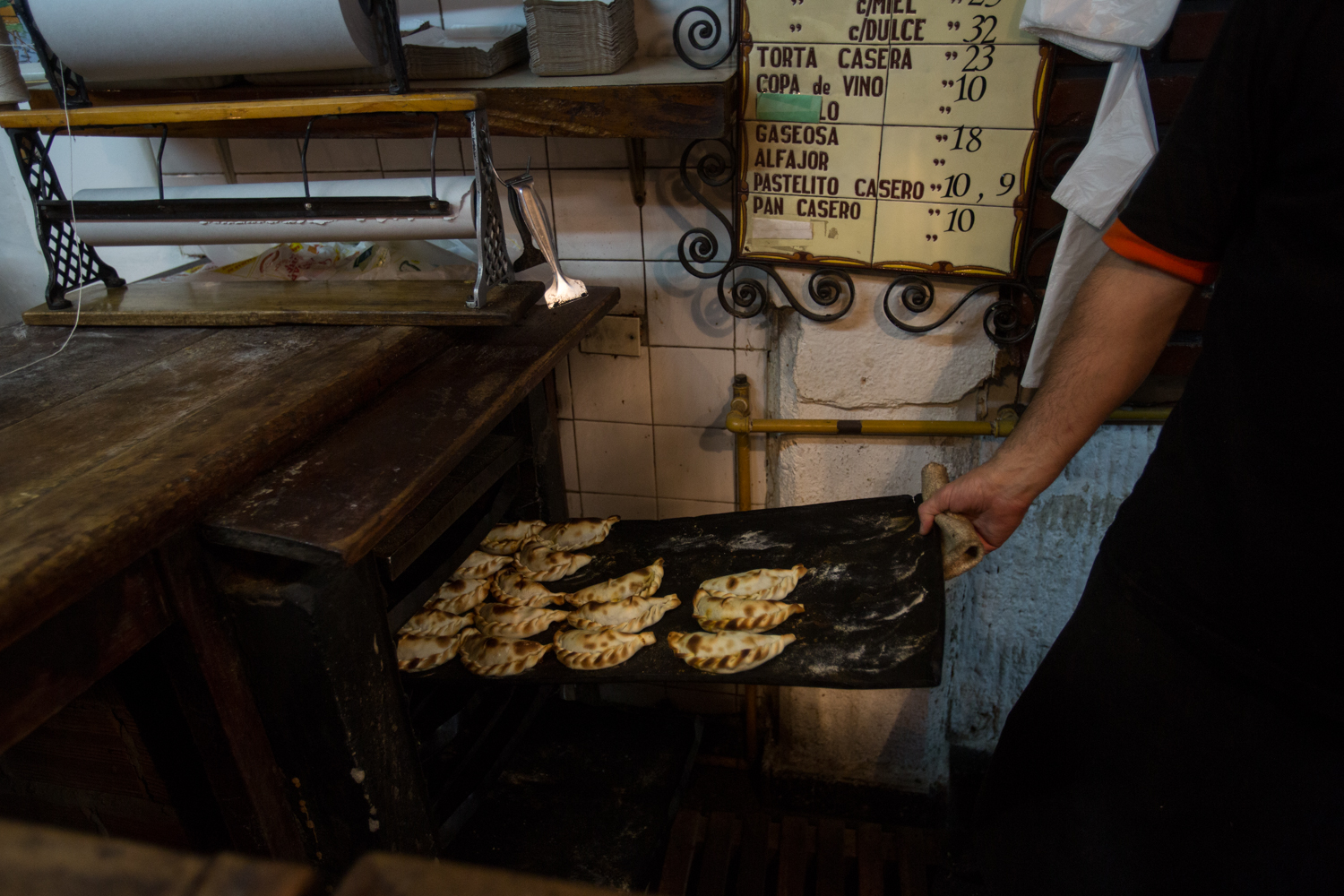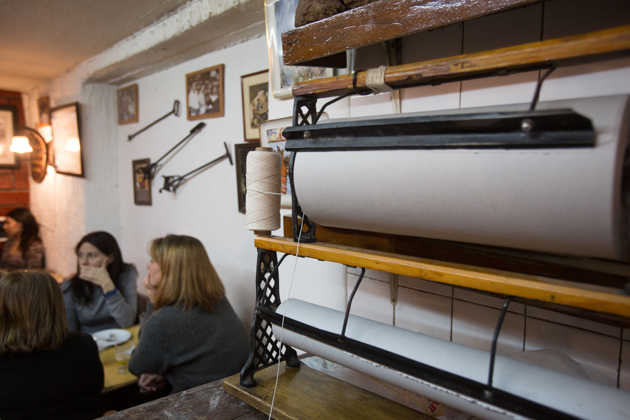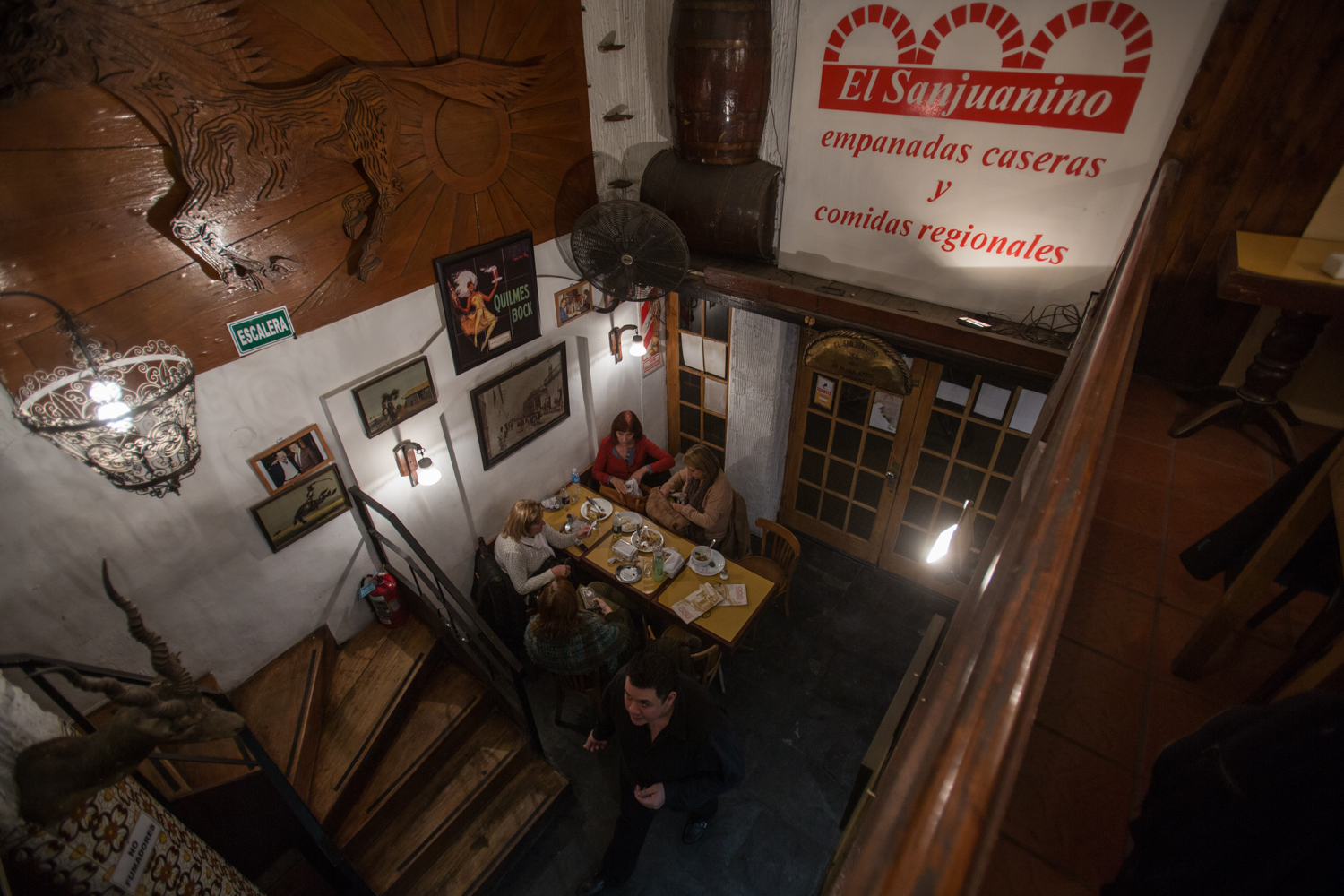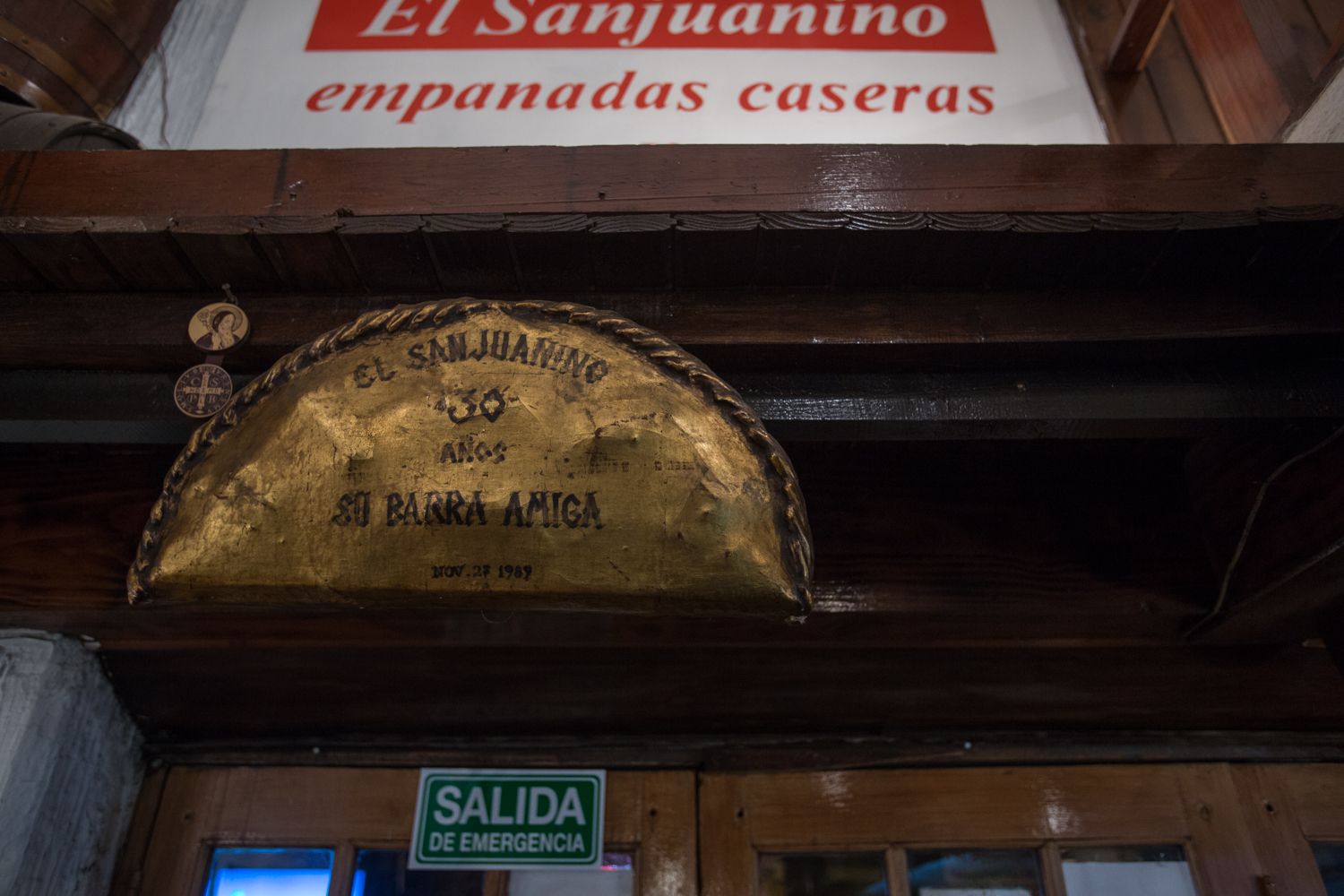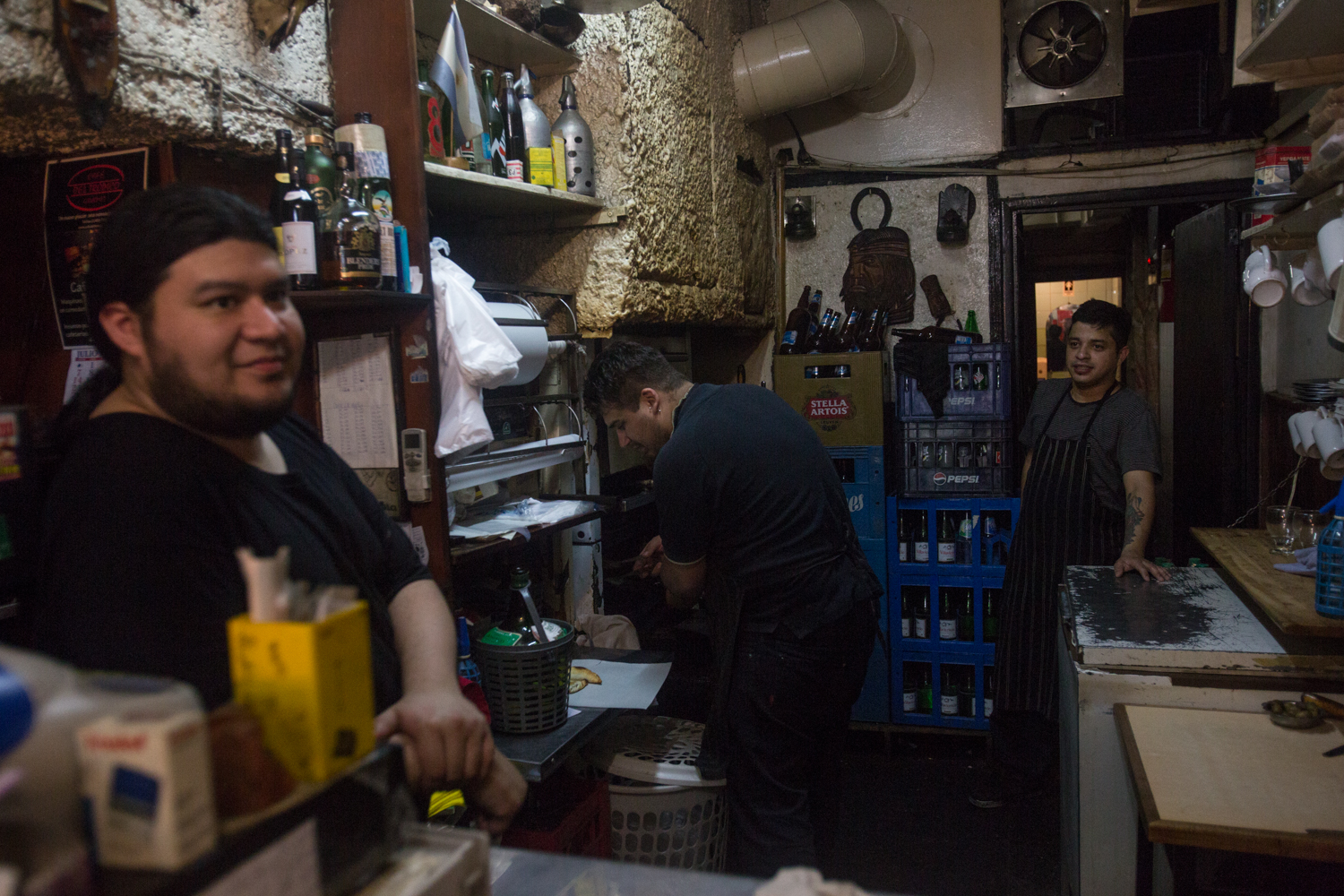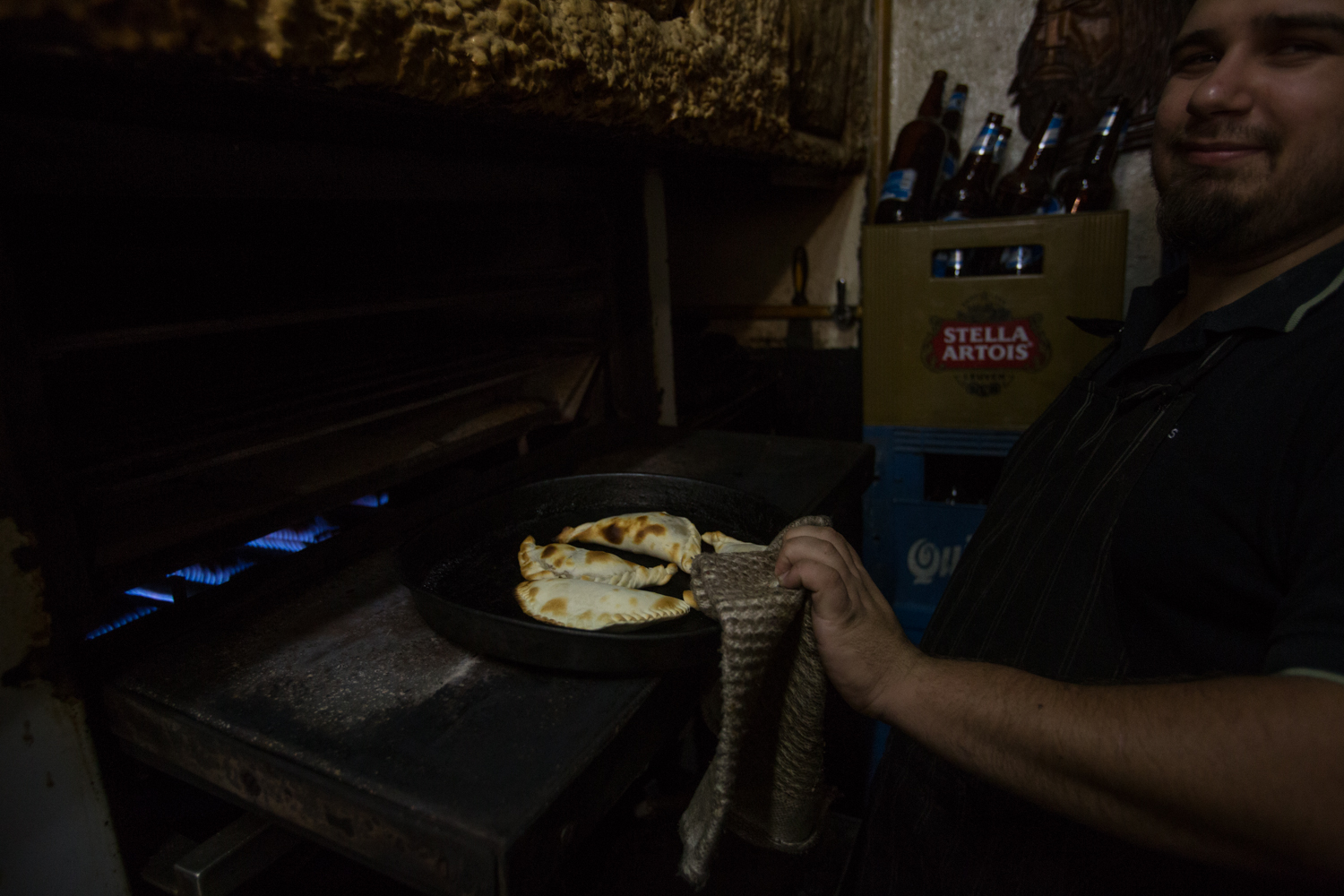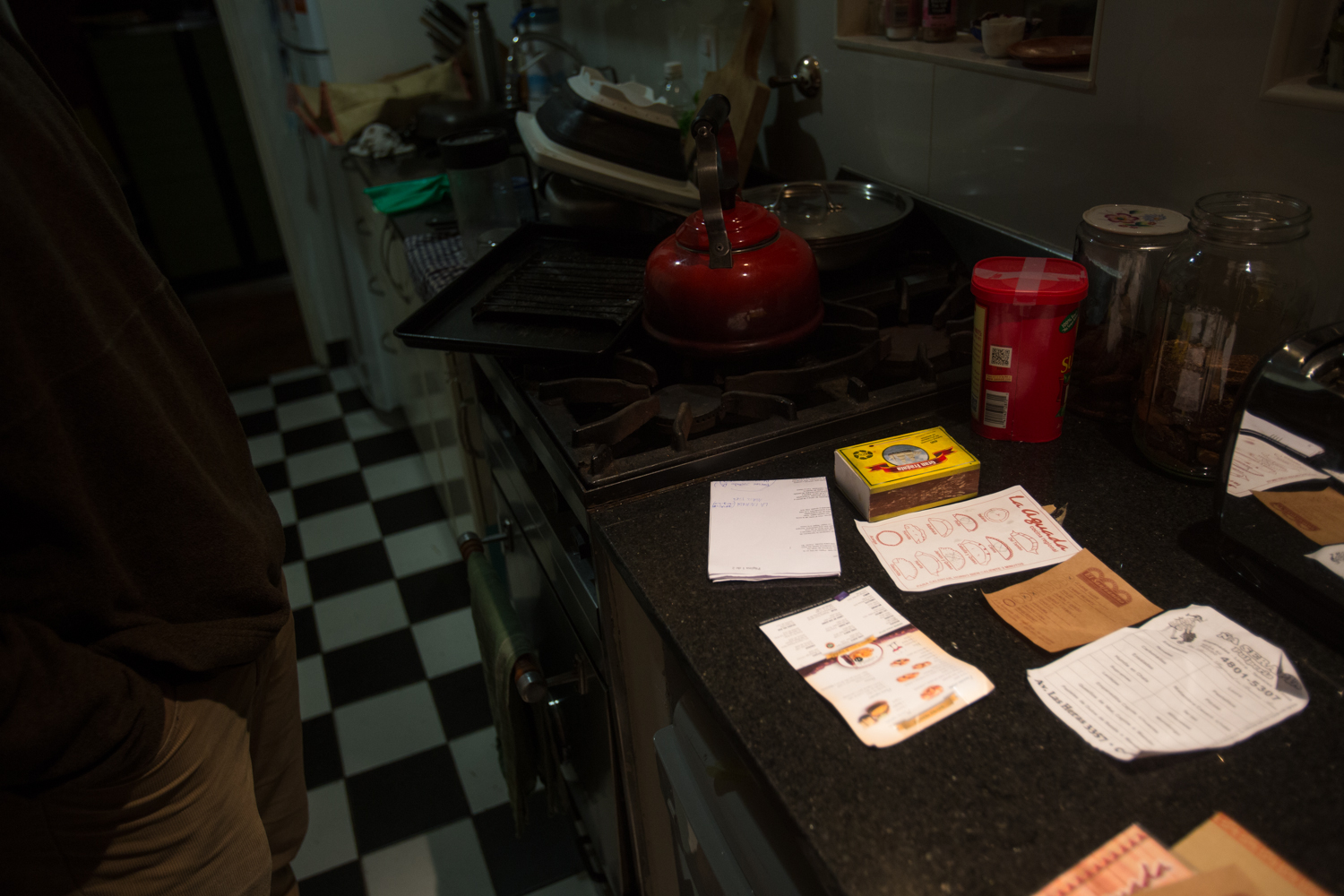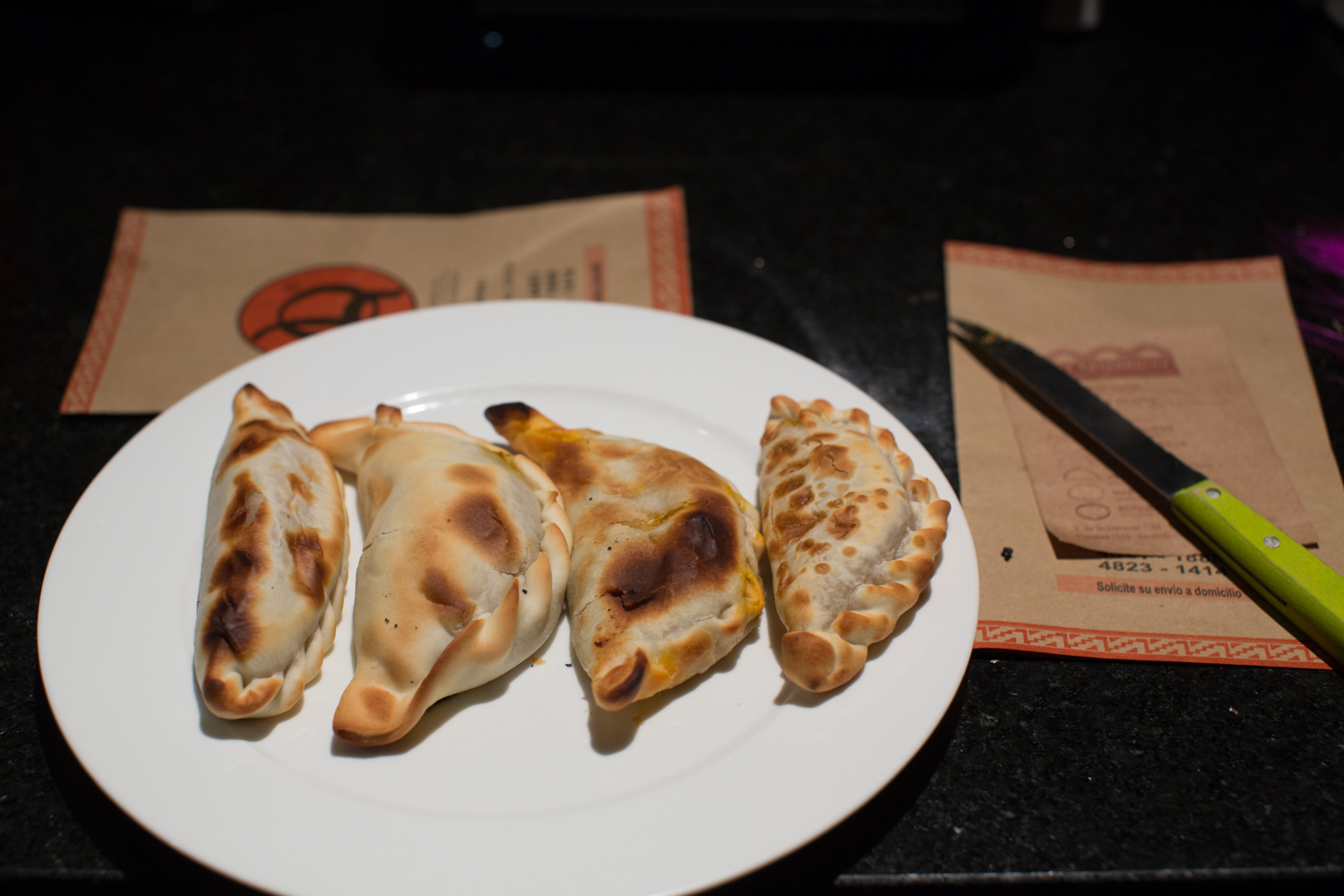Argentina 2 - Restaurant of the Year
There it sits amongst the wicker baskets and sugar bins, blank checks, cash register, free magnets, toothpick dispenser. It may, because of the seductive aromas within this place (or, because of your immediate imperative to get a table or place your order) elude your attention momentarily. But there's no doubt that this thing, a sculpture of a distinguished man wearing a sport jacket and tie with a crucifix pin attached to one of the lapels, will grab your attention when you see it: the man's dignified expression reflects strength and survival despite the presence of dripping blood and a knife wound to the heart. Why is it here?
Now, look there and notice the guy who's chatting with customers, serving food, and speaking with the cooks behind the counter. He's Hector Leonardo Yepez, the owner of this place – and the inspiration for the sculpture (5th photo in above slideshow). You'll see the resemblance. The piece, it turns out, is an ancillary work based upon "The Martyr," a photograph by Marcos Lopez, an Argentine photographer whose bright and colorful pictures depict staged poses of people in front of mundane backgrounds. A copy of "The Martyr," and articles about it, hang on one of the walls in the restaurant. According to Lopez ( I've translated from this article), "The man is suffering the pain of five centuries of colonialism and social injustice."
Amazing.
Yepez's restaurant is called Pulperia Ña Serapia, and it is Pizzacentric's 2013 Restaurant of the Year. Pizzacentric celebrates love-inspired, people-accessible food places that are many times hidden in plain sight – spots that lack media coverage but suffer no lack of virtuous food. For 2012, the honor was bestowed upon Ristorante Pizzeria Alpino, a restaurant located in the breathtaking Dolomite Mountains in Italy. This year, the winner is in Buenos Aires, about which I should say right here and now: you need to go there.
A quick explanation as to why the winner is again not in the US. Because sure, it could be here – we all know of places that qualify. But: (1) The majority of stories on PC already take place in New York; (2) Affordability means different things in different places, and "affordable" in New York is not necessarily affordable; and (3) Most importantly, I would love to inspire you to travel.
Before we get to why this tiny hole-in-the-wall place across the street from a largish city park near a university for which I don't even know the name is the 2013 Pizzacentric "Restaurant of the Year," let's turn to the topic of empanadas. Because without a doubt, empanadas are the pizza of Argentina.
The empanadas at Pizzeria El Cuartito.
Yes, there's plenty of standard-style pizza in Argentina. I wrote about one place, El Cuartito, in this story. The pizza was good and the pizzeria itself was real-deal cool. But it's the empanada – a small package of thinly-rolled soft dough filled, sealed, and baked with beef and/or others fillings – that is theubiquitous and affordable regionally-variable food of Argentina. In fact, many pizzerias offer, aside from pizza, very good homemade empanadas – and by this I don't mean those thawed-out orangish Jamaican patties like the ones you find in New York pizza shops. Not only are good empanadas common in Buenos Aires (and I imagine throughout the country, in particular in the northern provinces), but they are indeed a part of Argentina's cultural fabric in much the same way that pizza or hamburgers are here in the US.
According to Walter and Alejandra, our Argentine friends who for years had lived in Brooklyn, a mediocre Argentine empanada is still better than the best ones they had tried here in the US. When they invited us over for empanadas – which, lucky for us, occurred many times – Alejandra made the dough from scratch, baked them in the oven (rather than frying), and used the kinds of good ingredients that I myself would buy for cooking at home.
"In Argentina," she said, "I wouldn't bother to make empanadas. Why would I make do that? I can get such good ones so nearby and they're so cheap."
"But here," her husband, Walter added, speaking of the United States: "Here, it could be a very good business."
Alas when Walter's job assignment brought him and his family back to Argentina, I knew there was only one thing to do: we had to go there and see out for ourselves whether the US does indeed fall short in the category of empanada quality. And of course, visit our friends.
--
The night before we were supposed to leave early in the morning for a ferry that at 7am would take us across the widest river in the world from Argentina to Uruguay, Walter brought me on an empanada walk. When we returned to his apartment hours later our families were already in bed but Kristin got up to ask me what had taken us so long and how the empanadas were.
"We haven't eaten them yet. We're going to reheat them right now. Join us."
She shook her head, mentioned that it was crazy how late it was (it was nearly 11), and went back to bed.
During our visit, we ate empanadas from three excellent places that night and from several others at other times. All of the empanadas we had were from restaurants that, like good New York pizzerias, made the dough from scratch, had the owner present, and served excellent quality food possessing nuanced flavors. I must have eaten twenty or more empanadas while in Argentina and all of them were good.
Note: To an Argentine, only beef empanadas are worth evaluating. To judge a place based on its Chicken empanada would be like evaluating a pizzeria based on its slice topped with Buffalo chicken – you wouldn't do that.
However, I ate empanadas of all sorts.
On our first night we broke the ice by picking up a mixed batch of 17 from La Cocina, a tiny dark and charming spot not far from where our friends live. With a top-notch Malbec to sate our thirst (I'm convinced that Argentina's best wines stay in Argentina), this meal set the tone for what would be two weeks worth of great and affordable eating.
At Aguada, a cozy locals place, the straight-up Beef had just a hint of sweetness and, with chunky pieces of meat, was almost stew-like; the Chicken empanada was so pillowy it would win over any American in the "comfort food" category, its meaty filling bolstered with a warming dose of béchamel; and the Ham & Cheese, coated on top with a surprising glaze of sugar, was far from traditional but truly excellent.
The beef filling at El Sanjuanino, a small but inviting restaurant with tables on two levels, was made with olives, cumin, and onions; and the Verdure (chard) empanada must have included some béchamel in its prep but was packed with enough greens to feel super healthy.
At La Tucumanita, where there are no tables but only a counter with a couple of stools, Kristin, Alejandra, and I split a few non-meat specimens, each filled with cheesy oozy goodness. I wish we'd had more time at this place: I would have ordered seconds.
At La Morada, I sacrificed some stomach space in order to try Locro, a corn and meat stew that in the wintertime is a frequent co-star on the menu of nearly every empanaderia. I made sure to also try the Spicy Beef empanada. So glad that I did.
--
Those places were all very, very good – really! But Pulperia Ña Serapia took the cake in so many different ways. As soon as I stepped in there – well before I'd even tried their food – I knew it was special. Between the impression made by the owner and his gracious host-rapport with the customers that involved equal amounts of serving food and chatting; the bloody sculpture and photo which could not not intrigue the most blasé of people; and the clinking of glasses and tapping of forks against plates, and the happy and comfortable murmur of people conversing throughout the small room; and the employees who prepared food and, during down moments wiped used water beer bottles clean (presumably for recycling) – well, I felt like I'd discovered restaurant heaven.
And then, the empanadas. On the important matter of Beef, Serapia was the clear winner in our blind taste test on the night of the empanada walk. The dough had a flaky pastry-like quality and the filling of the Salteñas – diced beef, potato, and perhaps a little onion – was absolutely sublime.
I said to Walter, who was also tasting the empanadas from this place for the first time, "We must bring our families to this place. I have to go there again."
So return we did. On our final night in Argentina we seven crowded into the family VW and drove over there. The place was packed and we had to wait outside for about 20 minutes before being invited to sit at the back table. It was quite a squeeze but we didn't mind. Our meal included many incredible empanadas that everyone agreed were muy outstanding; a humida, which is a shaved corn, squash, and cheese tamale-like jammy; a beef and cornmeal tamale; an accompanying spicy homemade sauce that I loved so much I even (unsuccessfully) proposed to Kristin that we take some back to the US (we theorized that it was made from eggplant, tomato, onion, oil, chile flakes, and paprika); and for the adults to wash everything down, a pitcher of mediocre red wine that you blend 50/50 with seltzer to make it refreshing and palatable.
I do lament the fact that I don't speak Spanish. In several cases, but in particular at Serapia, I craved dialogue and information. It was difficult to be in a Ña Serapia, where there's so much good energy, and not converse with Hector – especially considering that his persona seemed so defined by his accessibility and friendliness. Walter and Alejandra spoke with him a bit and confirmed to me that he's a cool guy.
--
Next time I visit Argentina, I will again eat at this place. But I will also head north to the Salta, Jujuy, and Tucumán provinces – places from which many Argentine empanada styles originate.
One further note on travelling to Argentina: getting there is most of the battle. Round trip fares from New York fluctuate in the $900-$1400 range, but once there you can take advantage of an exchange rate that strongly favors the US Dollar and you'll find that it's not such an expensive trip after all. An upcoming post will delve into the Argentine currency and the confusing situation of multiple exchange rates.
--
Note #1: Empanadas in Buenos Aires are inexpensive. In general, they cost between $US 1.00 and $US 2.50 per empanada, with most of the ones we encountered in the lower part of that range. The number of empanadas that constitute a meal depends on their size and your appetite. It seems like 2-4 is the range for an average eater. Prices in USD are based on the "black market" exchange rate that we got during the summer of 2012, AR $8.5 per US $1.
Spoiler alert for Note #2: If you're a vegetarian and you want to eat empanadas read no further.
Note #2: I don't know for certain but according to Walter, empanada dough is "most certainly made with lard." I advise, if you've read this far and the presence of lard concerns you, that you make an exception and eat Argentine empanadas anyway.
Note #3: Argentines pronounce the Spanish "y" sound (written with either "ll" or "y") with a "sh" sound. So if an Argentine asks you your name in Spanish, "Cómo se llama?," they'll pronounce it, "Cómo se shamah?" Likewise, I live in "New Shork," not "New York." Etc.
--
The Winner:
Pulperia Ña Serapia. Av. Las Heras 3357, Buenos Aires, Argentina. Tel. 4801-5307. Map Pulperia Ña Serapia. Call for hours.
The others (all good):
La Cocina. Av. Pueyrredón 1508, Buenos Aires, Argentina. Tel. 4825-3171. Map La Cocina. Hours: Monday-Saturday, 11am-4pm and 6pm-Midnight (closed Sundays). Second downtown location is at Florida 142 in the Galleria Boston.
Aguada. Billinghurst 1862, Buenos Aires, Argentina. Tel. 4827-9477/1802. Map Aguada. Hours: Daily 11am-3pm and 7pm-11:30pm. Website: http://www.laaguadacocina.com.ar/.
El Sanjuanino. Avenida Callao (Posadas) 1515, Buenos Aires Argentina. Tel. 4804-2909. Map El Sanjuanino. Hours: Daily Noon-4pm and 7pm-1am. Second location is at Sánchez de Bustamante 1788, in the Palermo section of B.A. Website: http://www.elsanjuanino.co/.
La Tucumanita. Arenales 2882, Buenos Aires, Argentina. Tel. 4821-4617 or 4826-2136. Map La Tucumanita. Website: http://www.latucumanita.com.ar/. Two other locations, consult website for details. Call for hours.
La Morada. Larrea 1336, Buenos Aires, Argentina. Tel. 4821-6349. Map La Morada, Recoleta location. Website: http://www.lamorada.com.ar. Second location is at Hipolito Yrigoyen 778. Call for hours.
